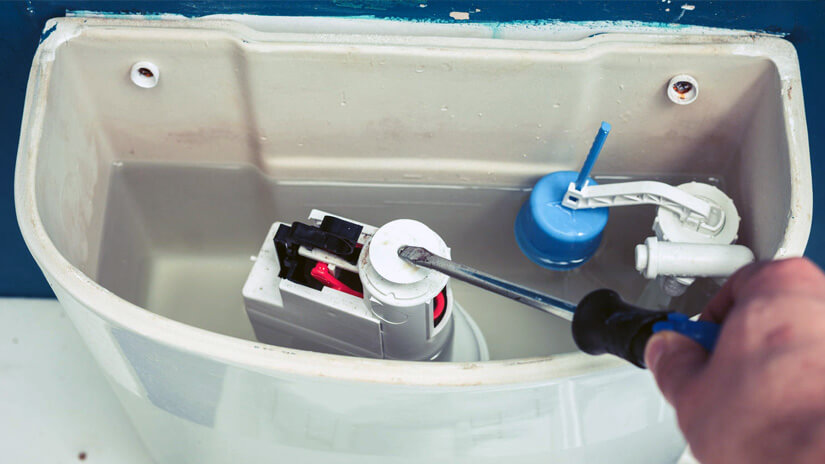Introduction:
A running toilet can be an exasperating and wasteful plumbing issue that many homeowners encounter. The incessant sound of water flowing can not only be irritating but can also lead to increased water bills and potential damage to the toilet and surrounding areas. In this comprehensive guide, we’ll delve deeper into the common causes behind a toilet that keeps running after a flush and provide practical and detailed solutions to address the issue effectively.
1. Understanding the Flush Mechanism:
To successfully troubleshoot a running toilet, it’s crucial to comprehend how the flush mechanism operates. The inner workings of the tank involve a complex interplay of components, including the flapper, fill valve, flush valve, and float. These components collaborate to control the flushing and refilling process.
2. Faulty Flapper:
The flapper, a rubber valve that seals the flush valve, is one of the primary culprits for a running toilet. A flapper that fails to create a proper seal will allow water to continuously leak into the bowl, resulting in the toilet running incessantly.
Carefully inspect the flapper for signs of damage or misalignment, and if necessary, consider replacing it to restore an effective seal.
3. Adjusting the Float:
The float, typically a ball or cup connected to the fill valve, plays a pivotal role in controlling the water level in the tank. If the float is set too high, it can cause water to flow continuously into the overflow tube.
To rectify this, adjust the float to ensure it allows the tank to fill to the correct level, stopping water flow when it reaches the set mark.
4. Issues with the Fill Valve:
A malfunctioning fill valve is another potential cause of a running toilet. If the fill valve fails to shut off properly, water will persistently flow into the tank. Thoroughly inspect the fill valve for any signs of wear, and if identified, consider replacing it to restore the proper functioning of the fill valve.
5. Checking for Leaks:
Leakages around the tank and bowl or in the supply line can contribute significantly to a running toilet. Vigilantly inspect for any visible leaks and tighten connections as necessary.
A dye test can also prove useful in identifying less noticeable leaks – place a few drops of food coloring in the tank and observe whether it appears in the bowl without flushing.
6. Mineral Buildup:
Over time, mineral deposits can accumulate in the toilet’s components, affecting their functionality. It’s imperative to clean the parts regularly, paying special attention to the flapper and flush valve, to remove any mineral buildup that may be impeding a proper seal.
7. Replacing Worn Out Parts:
If your toilet is aging, worn-out parts may be the root cause of the constant running. Consider a comprehensive replacement of components such as the flapper, fill valve, and flush valve to restore proper functionality and prevent recurrent issues.
FAQs:
Q1: Why does my toilet keep running after I flush it?
A1: The most common reasons include a faulty flapper, issues with the fill valve, a misadjusted float, leaks, or mineral buildup.
Q2: How can I fix a running toilet myself?
A2: Depending on the issue, you may need to adjust the float, replace the flapper or fill valve, clean components, or fix any leaks. Detailed steps for each scenario are outlined in the preceding sections.
Q3: Is a running toilet a significant water waster?
A3: Yes, a running toilet can waste a substantial amount of water over time, leading to higher water bills and contributing to environmental impact.
Q4: Can a running toilet cause damage to my bathroom?
A4: Indeed, a running toilet can result in damage to the flooring, subfloor, and even the ceiling below if the water leakage is severe and goes unnoticed. Prompt attention and resolution are crucial.
Q5: How often should I inspect and maintain my toilet to prevent running issues?
A5: Regular inspections, at least annually, can help catch and address potential issues before they escalate into a running toilet. Periodic maintenance, including cleaning and component checks, is essential for optimal toilet performance.
Conclusion:
In conclusion, a running toilet is a prevalent household problem, but armed with a comprehensive understanding of the flush mechanism and the troubleshooting steps outlined in this guide, homeowners can identify and resolve the cause effectively. By addressing the root issues, not only can water be conserved, but potential damage to the bathroom can also be averted. If problems persist or if you’re unsure about the diagnosis, seeking professional plumbing assistance is advisable for a thorough inspection and precise resolution of the issue. Remember, a properly functioning toilet is not only a matter of convenience but also a step towards a more sustainable and cost-effective home.

A group of home improvement enthusiasts and bathroom design experts, combines in-depth knowledge and a shared passion to deliver engaging, informative content that guides readers through the world of bathroom innovation and style.

Leave a Reply